MaryAnn Bernal's Blog, page 198
February 8, 2015
History Trivia - Mary, Queen of Scots, executed
February 8
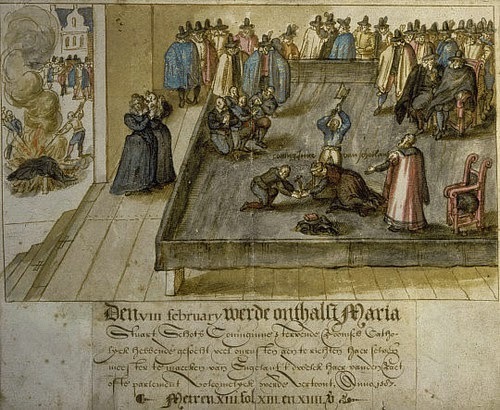
1587 After twenty years of captivity in England, Mary, Queen of Scots was executed at Fotheringay Castle, Northamptonshire, on suspicion of having been involved in the Babington Plot to murder her cousin, Queen Elizabeth I.

1601 Robert Devereux, 2nd Earl of Essex, rebelled against Queen Elizabeth I, but the revolt was quickly crushed.

1622 King James I of England disbanded the English Parliament.

1587 After twenty years of captivity in England, Mary, Queen of Scots was executed at Fotheringay Castle, Northamptonshire, on suspicion of having been involved in the Babington Plot to murder her cousin, Queen Elizabeth I.

1601 Robert Devereux, 2nd Earl of Essex, rebelled against Queen Elizabeth I, but the revolt was quickly crushed.

1622 King James I of England disbanded the English Parliament.
Published on February 08, 2015 02:30
February 7, 2015
Designs revealed for Iceland's first pagan temple in 1,000 years
 By Matt Finn
By Matt FinnFox News
For the first time in 1,000 years a new pagan temple is being constructed in Iceland’s capital city that will house a shrine to the Norse gods Thor, Odin and Frigg.
“We see this as so much part of our heritage,” said Hilmar Orn Hilmarsson, high priest of the Asatru religion.
The temple is ten years in the making and is currently under construction. The 4,000 square foot facility will overlook the Icelandic capital and be completed in 2016. It will give Icelanders the opportunity to publicly worship at the shrine to gods. “Some people love the idea, they really want to go back to the Viking era,” Hilmarsson said.
Iceland was originally founded by pagan settlers. Asatru remained the sole religion of the country for over 100 years until it gave way to Christianity in the year 1000. Some Icelanders experienced religious conflicts with northern European countries.
“Some Icelanders converted to Christianity, but it was a business deicision because some business owners would not trade with pagans,” Hilmarsson said.
The high priest tells Foxnews.com Norse paganism experienced a revival in Iceland beginning in the 1970’s that’s paved the way for the new temple.
The temple will serve as a place of worship but it won’t be a lively or organized celebration.
“It’s more like coming together, sanctifying the movement, having a sacred space,” Hilmarsson said. “More close to Hindu ceremonies.”
Hilmarsson said Thor, Ordin and Frigg are important deities in the religion. Thor is the protector of mankind, Ordin is the god of wisdom and poetry, and Frigg is the goddess of domestic and love.
If names like Thor ring a bell, it might be because some Asatru gods have recently seen a surge in America thanks to Marvel’s blockbuster films about them.
“There is a skewed vision because the Marvel version is like a Shakespeare,” Hilmarsson said. “We certainly enjoy them but don’t see them as religious in any sense.
The priest said the gods are viewed as mystical and symbolic. Most modern worshipers don’t consider them to be living beings that are capable of flying down from the clouds.
“We don’t tend to be literal in our beliefs in Iceland, not even the Christian ones,” Hilmarsson said.
The Asatru religion might describe itself as poetic--but if some Christians, especially those in the Western hemisphere, were to take a literal look at the new altar to pagan gods they might consider it satanic. Hilmarsson says Norse is the opposite of devil worship.
“There is nothing remotely satanic or demonic in this,” Hilmarsson said. “This is a very gentle movement on how to be a good friend, good to your family and an honorable person.”
Hlynur Gudjonsson, the Consul General and Trade Commissioner of Iceland’s consulate in New York tells Foxnews.com that most American’s might not understand what Asatru is—but those who do realize it’s a peaceful practice.
“I’ve never met anyone who has anything negative to say about it,” Gudjonsson said.
Published on February 07, 2015 07:37
History Trivia - bonfire of the vanities
February 7
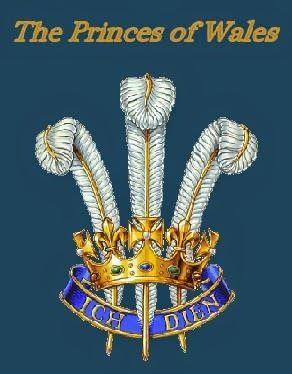
1301 Edward, eldest son of Edward I was made the first English Prince of Wales, a tradition continued to this day.

1477 Saint Thomas More was born. More was martyred for refusing to accept King Henry VIII as head of the Church of England.
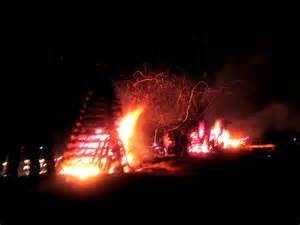
1497 the bonfire of the vanities occurred in which supporters of Girolamo Savonarola burned thousands of objects like cosmetics, art, and books in Florence, Italy.

1550 Julius III became pope. He maintained excellent diplomatic relations with England's Queen Mary Tudor during her turbulent reign, and expanded the Vatican Library, supported universities, and was keenly interested in the arts.

1301 Edward, eldest son of Edward I was made the first English Prince of Wales, a tradition continued to this day.

1477 Saint Thomas More was born. More was martyred for refusing to accept King Henry VIII as head of the Church of England.

1497 the bonfire of the vanities occurred in which supporters of Girolamo Savonarola burned thousands of objects like cosmetics, art, and books in Florence, Italy.

1550 Julius III became pope. He maintained excellent diplomatic relations with England's Queen Mary Tudor during her turbulent reign, and expanded the Vatican Library, supported universities, and was keenly interested in the arts.
Published on February 07, 2015 02:30
February 6, 2015
Discovery Of Neolithic Gift Shop Suggests Stonehenge Always Meant As Tourist Attraction
 The Onion
The OnionWILTSHIRE, ENGLAND—In a significant finding that sheds new light on the mysterious monument’s past, a team of archaeologists working near Stonehenge this week unearthed the remnants of a primitive gift shop, suggesting that the site had always served as a tourist attraction. “After uncovering piles of Stone Age goblets, deer-hide tunics, and animal-bone bracelets all etched with images of Stonehenge, we realized that this was not an ancient Celtic ritual site or Druidic pilgrimage destination as previously thought, but instead a popular attraction for Neolithic vacationers,” said lead researcher Amelia Stroud of Oxford University, who explained that preserved footprints found at the site indicated that ancient visitors had to walk through the gift area on their way out of the circular stone structure. “We also found a wide array of ancient coins at the site, clear evidence that large bands of Romans and Anglo-Saxon tribesmen came from far away to visit the attraction and were charged exorbitant prices while there.” Stroud went on to speculate that numerous small rocks found scattered around the site were most likely the remains of prehistoric “Make Your Own Stonehenge” kits
Published on February 06, 2015 14:59
Mysterious Stone Carving May Contain Old Message
by Owen Jarus
Live Science
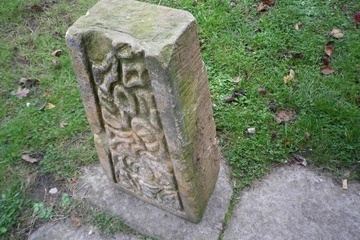 James Balme, an archaeologist and TV
James Balme, an archaeologist and TV presenter, discovered this stone carving in a garden in Leicester, England, where it was up for sale as a garden ornament. He recognized it was no ordinary ornament and purchased it.
presenter, discovered this stone carving in a garden in Leicester, England, where it was up for sale as a garden ornament. He recognized it was no ordinary ornament and purchased it.
Credit: James Balme View full size image
A weighty stone carved with a mysterious pattern that may be writing has been discovered in a garden in Leicester, England.
The hefty carving was up for sale as a garden ornament when archaeologist and TV presenter James Balme found it. The carving, which was very dirty, may have been plowed up many years ago, Balme said. Despite the carving's poor shape, he thought it was no ordinary ornament; so he purchased it and carefully cleaned it.
it and carefully cleaned it.
When he was done conserving it, Balme saw a stone carving with an extremely complex pattern that is difficult to describe. It's possible the "pattern carved may be some form of writing," Balme told Live Science in an email . The carving's use is unknown, though it could be "a keystone from an archway or indeed a vaulted ceiling," Balme said. [7 Most Mysterious Archaeological Finds on Earth]
. The carving's use is unknown, though it could be "a keystone from an archway or indeed a vaulted ceiling," Balme said. [7 Most Mysterious Archaeological Finds on Earth]
The carving, which weighs between 55 and 65 pounds (25 and 30 kilograms), appears to be made out of a hard form of sandstone, Balme said. It's wide at its base but get narrower toward the top. It stands about 18 inches (46 centimeters) high and is 5.5 inches (14 cm) thick. Its decorations are entirely on the front face "although it does have many chisel marks on the sides and back," he said.
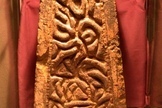 [image error]
[image error]
 The carving, shown here after it was restored, may date back to the Anglo-Saxon period, between the fifth and 11th centuries A.D.
The carving, shown here after it was restored, may date back to the Anglo-Saxon period, between the fifth and 11th centuries A.D.
Credit: James BalmeView full size imageThe date of the carving is uncertain. Balme says that it may date to the Anglo-Saxon period, which started in 410 when the Roman Empire abandoned Britain, and lasted until 1066, when a group called the Normans, led by William the Conqueror, invaded England.
During the Anglo-Saxon period several different groups migrated to England. These people created fine works of art such as complex stone carvings, some of which survive today. Literature also flourished at this time, the poem "Beowulf" being one of the most famous works from this period.
Although an Anglo-Saxon date for the stone carving is a distinct possibility , Balme cannot be certain. Questions also remain as to what exactly the carving was used for and whether the pattern may represent some form of writing. Balme has taken to Twitter, seeking help to unravel the carving's mysteries.
, Balme cannot be certain. Questions also remain as to what exactly the carving was used for and whether the pattern may represent some form of writing. Balme has taken to Twitter, seeking help to unravel the carving's mysteries.
Garden ornament archaeology
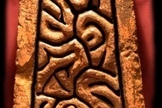 [image error]
[image error]
 Photo enhancement of the carving sheds more light on the pattern and Balme wonders if this could be some form of writing.
Photo enhancement of the carving sheds more light on the pattern and Balme wonders if this could be some form of writing.
Credit: James BalmeView full size image"Garden ornament" may conjure up images of tacky gnomes or other modern-day items. However, over the past few years archaeologists studying garden ornaments have made several interesting discoveries. In 2009, the BBC reported on a garden ornament in Dorset that turned out to be an ancient Egyptian terracotta vase.
Another, more spectacular, example of garden ornament archaeology comes from the modern-day town of Migdal located near the Sea of Galilee in Israel. A team of archaeologists studied ancient architectural remains in Migdal that were being reused as garden ornaments or chairs. These remains aided them in discovering an ancient town, which would have flourished at the time of Christ.
So the next time you see an old garden ornament that seems out of place, remember, you may be looking at an interesting piece of history.
Live Science
 James Balme, an archaeologist and TV
James Balme, an archaeologist and TV presenter, discovered this stone carving in a garden in Leicester, England, where it was up for sale as a garden ornament. He recognized it was no ordinary ornament and purchased it.
presenter, discovered this stone carving in a garden in Leicester, England, where it was up for sale as a garden ornament. He recognized it was no ordinary ornament and purchased it. Credit: James Balme View full size image
A weighty stone carved with a mysterious pattern that may be writing has been discovered in a garden in Leicester, England.
The hefty carving was up for sale as a garden ornament when archaeologist and TV presenter James Balme found it. The carving, which was very dirty, may have been plowed up many years ago, Balme said. Despite the carving's poor shape, he thought it was no ordinary ornament; so he purchased
 it and carefully cleaned it.
it and carefully cleaned it.When he was done conserving it, Balme saw a stone carving with an extremely complex pattern that is difficult to describe. It's possible the "pattern carved may be some form of writing," Balme told Live Science in an email
 . The carving's use is unknown, though it could be "a keystone from an archway or indeed a vaulted ceiling," Balme said. [7 Most Mysterious Archaeological Finds on Earth]
. The carving's use is unknown, though it could be "a keystone from an archway or indeed a vaulted ceiling," Balme said. [7 Most Mysterious Archaeological Finds on Earth] The carving, which weighs between 55 and 65 pounds (25 and 30 kilograms), appears to be made out of a hard form of sandstone, Balme said. It's wide at its base but get narrower toward the top. It stands about 18 inches (46 centimeters) high and is 5.5 inches (14 cm) thick. Its decorations are entirely on the front face "although it does have many chisel marks on the sides and back," he said.
 [image error]
[image error]
 The carving, shown here after it was restored, may date back to the Anglo-Saxon period, between the fifth and 11th centuries A.D.
The carving, shown here after it was restored, may date back to the Anglo-Saxon period, between the fifth and 11th centuries A.D.Credit: James BalmeView full size imageThe date of the carving is uncertain. Balme says that it may date to the Anglo-Saxon period, which started in 410 when the Roman Empire abandoned Britain, and lasted until 1066, when a group called the Normans, led by William the Conqueror, invaded England.
During the Anglo-Saxon period several different groups migrated to England. These people created fine works of art such as complex stone carvings, some of which survive today. Literature also flourished at this time, the poem "Beowulf" being one of the most famous works from this period.
Although an Anglo-Saxon date for the stone carving is a distinct possibility
 , Balme cannot be certain. Questions also remain as to what exactly the carving was used for and whether the pattern may represent some form of writing. Balme has taken to Twitter, seeking help to unravel the carving's mysteries.
, Balme cannot be certain. Questions also remain as to what exactly the carving was used for and whether the pattern may represent some form of writing. Balme has taken to Twitter, seeking help to unravel the carving's mysteries.Garden ornament archaeology
 [image error]
[image error]
 Photo enhancement of the carving sheds more light on the pattern and Balme wonders if this could be some form of writing.
Photo enhancement of the carving sheds more light on the pattern and Balme wonders if this could be some form of writing.Credit: James BalmeView full size image"Garden ornament" may conjure up images of tacky gnomes or other modern-day items. However, over the past few years archaeologists studying garden ornaments have made several interesting discoveries. In 2009, the BBC reported on a garden ornament in Dorset that turned out to be an ancient Egyptian terracotta vase.
Another, more spectacular, example of garden ornament archaeology comes from the modern-day town of Migdal located near the Sea of Galilee in Israel. A team of archaeologists studied ancient architectural remains in Migdal that were being reused as garden ornaments or chairs. These remains aided them in discovering an ancient town, which would have flourished at the time of Christ.
So the next time you see an old garden ornament that seems out of place, remember, you may be looking at an interesting piece of history.
Published on February 06, 2015 07:50
Drought may soon yield mysterious WWII-era bomber beneath Lake Mead
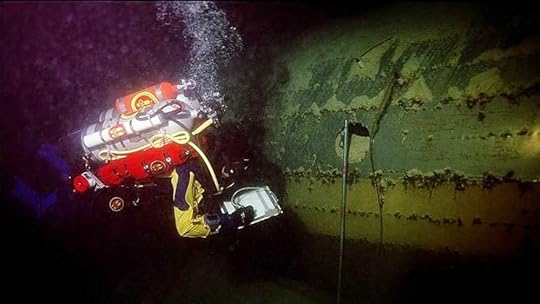 Water levels are at their lowest at Nevada's Lake Mead leading the National Park Sevice to allow permits for recreational diving at the site of a downed B-29 bomber. (National Park Service)
Water levels are at their lowest at Nevada's Lake Mead leading the National Park Sevice to allow permits for recreational diving at the site of a downed B-29 bomber. (National Park Service)By Perry Chiaramonte
Fox News
The drought that has parched much of the southwest may soon yield a mystery that has rested at the bottom of Nevada's Lake Mead for nearly 70 years, a B-29 bomber that went down carrying a top-secret missile defense system that may have actually caused the crash.
The B-29 bomber, also known as the "Superfortress" and the same model as the storied Enola Gay and Bockscar, the planes that dropped atomic bombs on Japan, crashed in 1948 as it flew over the giant lake testing a sun-powered missile guidance system. For decades, it lay at a depth of 300 feet in the man-made lake that was formed by construction of the Hoover Dam. But the drought has lowered water levels to the point where the plane is just 110 feet down, well within the range of recreational divers.
"There's a lot of history there. The site would be right up there with any shipwreck for a diver."
- Curtis Snaper, Sin City Scuba"It would be amazing," Curtis Snaper, of Sin City Scuba in nearby Las Vegas, told FoxNews.com. "There's a lot of history there. The site would be right up there with any shipwreck for a diver."
The B-29 at the bottom of Lake Mead was one of the last of its kind to be built. The U.S. Army Air Forces, which would later become the U.S. Air Force, received it days after Japan surrendered, on Sept. 2, 1945. Two years later, the plane was stripped of its defensive armament and was turned over to the military’s Upper Atmosphere Research Project. When it went down on June 21, 1948, the plane and its five-man crew were testing a secret ballistic-missile guidance system known as a "sun-tracker," according to the blog War is Boring. According to the blog, the highly-classified device, mounted in a dorsal dome atop the bomber’s fuselage, allowed a missile to get its elevation and orientation from sighting the sun.
Testing it required the B-29’s crew to repeatedly ascend to 35,000 feet, then drop to just 100 feet above the lake. But, according to the blog, the lake's surface reflected the sun, and may have caused Capt. Robert Madison to lose depth perception. The plane skimmed into the lake at 230 miles per hour, and while the crew escaped on life rafts, the plane dropped to the murky depths.Better-equipped divers, using a special helium-rich gas mixture, for example, have been secretly exploring the crash site since 2001, when it was first discovered in the giant lake's Overton Arm section. But scuba divers have been officially banned by the National Park Service from exploring the site because of the dangers associated with such depths. With Lake Mead at record low levels, the federal agency intends to grant permits for diving the bomber, beginning in April.
Related Image
 Expand / ContractA National Park schematic of the downed plane. (National Park Service)
Expand / ContractA National Park schematic of the downed plane. (National Park Service)But it was not simply the danger to divers that prompted the Park Service to protect it from mistreatment and to prevent recreational divers from going down to the wreckage site. The agency is also concerned that weekend warriors could damage the wreck. In 2002, it sent a remote-controlled submarine down to explore the wreckage, and discovered ropes and lights from previous dives. A year later, technical divers sent down by the Parks Service found signs of damage and looting.
In 2007, the agency allowed two licensed dive operators to lead guided scuba tours of the site, but demand was limited.
“It was costly to dive,” said Steve Schafer of Lake Mead Technical Dives, which led a handful of tours, charging divers $450 each. “We weren’t even allowed to keep a boat on the water to make things go quickly.”
 Expand / ContractLevels at Lake Mead were once at 300 feet makeing the wreckage site unaccessable to recreational divers, but a severe drought in the region has brought levels down to just over 100 feet. (LakeMeadTechnicalDivers.com)
Expand / ContractLevels at Lake Mead were once at 300 feet makeing the wreckage site unaccessable to recreational divers, but a severe drought in the region has brought levels down to just over 100 feet. (LakeMeadTechnicalDivers.com)Plunging water levels have made the site much more accessible, and likely much cheaper, for recreational scuba divers, although they would still have to be accompanied by approved guides. The Parks Service plans to offer a two-year, commercial-use permit allowing guides to take up to 100 divers per year down to the wreck.
“We have had people express an interest over the years," Christie Vanover, a spokesperson for Lake Mead National Recreation Area said to the Las Vegas Review-Journal. We think this is the best option, and it provides a business opportunity.”
Published on February 06, 2015 07:43
History Trivia - Riots of Lynn in Norfolk spread to Norwich England
February 6
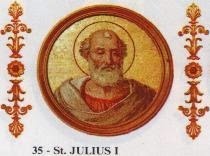
337 St Julius I began his reign as Catholic Pope. Julius is credited with setting Jesus' birthday on December 25th.

1189 Riots of Lynn in Norfolk spread to Norwich England. The riots began in Lynn when the Jews attempted to attack a baptized coreligionist who had taken refuge in a church. The seafaring population rose against them, fired their houses, and put them to the sword.1508 Maximilian I crowned Holy Roman Emperor.

1685 James II of England and VII of Scotland became King upon the death of his brother Charles II.

337 St Julius I began his reign as Catholic Pope. Julius is credited with setting Jesus' birthday on December 25th.

1189 Riots of Lynn in Norfolk spread to Norwich England. The riots began in Lynn when the Jews attempted to attack a baptized coreligionist who had taken refuge in a church. The seafaring population rose against them, fired their houses, and put them to the sword.1508 Maximilian I crowned Holy Roman Emperor.

1685 James II of England and VII of Scotland became King upon the death of his brother Charles II.
Published on February 06, 2015 03:00
February 5, 2015
History Trivia - Marcus Cato, the Roman philosopher, commits suicide
February 5

46 BC, Marcus Cato, the Roman philosopher, committed suicide by stabbing himself, after learning of the victory of his enemy, Julius Caesar, over Pompey at Thapsus.

62 Pompeii and Herculaneum were severely damaged by an earthquake.
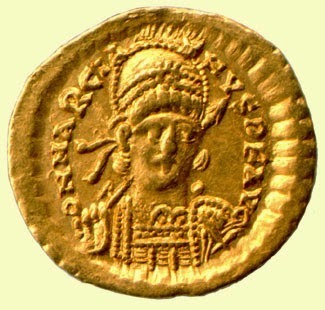
1204 Alexius V was proclaimed Eastern Roman Emperor during the siege of Constantinople.

46 BC, Marcus Cato, the Roman philosopher, committed suicide by stabbing himself, after learning of the victory of his enemy, Julius Caesar, over Pompey at Thapsus.

62 Pompeii and Herculaneum were severely damaged by an earthquake.

1204 Alexius V was proclaimed Eastern Roman Emperor during the siege of Constantinople.
Published on February 05, 2015 02:00
February 4, 2015
Taj Mahal Gardens Found to Align with the Solstice Sun
 The gardens
The gardens of the Taj Mahal align with the rising and setting sun during the summer and winter solstices, new research shows. Although the alignments likely had symbolic meanings, the solstice sun could also have served a practical purpose, helping architects build the Taj Mahal and its gardens precisely.
of the Taj Mahal align with the rising and setting sun during the summer and winter solstices, new research shows. Although the alignments likely had symbolic meanings, the solstice sun could also have served a practical purpose, helping architects build the Taj Mahal and its gardens precisely.Credit: saiko3p/Shutterstock.com
by Owen Jarus
Live Science
If you arrived at the Taj Mahal in India before the sun rises on the day of the summer solstice (which usually occurs June 21), and walked up to the north-central portion of the garden
 where two pathways intersect with the waterway, and if you could step into that waterway and turn your gaze toward a pavilion to the northeast — you would see the sun rise directly over it.
where two pathways intersect with the waterway, and if you could step into that waterway and turn your gaze toward a pavilion to the northeast — you would see the sun rise directly over it.If you could stay in that spot, in the waterway, for the entire day, the sun would appear to move behind you and then set in alignment with another pavilion, to the northwest. The mausoleum and minarets of the Taj Mahal are located between those two pavilions, and the rising and setting sun would appear to frame them.
Although standing in the waterway is impractical (and not allowed), the dawn and dusk would be sights to behold, and these alignments are just two among several that a physics researcher recently discovered between the solstice sun and the waterways, pavilions and pathways in the gardens of the Taj Mahal.
The Taj Mahal is a mausoleum built by Mughal Dynasty emperor Shah Jahan (who lived from 1592 to 1666) for his favorite wife Mumtaz Mahal (who lived 1592-1631). Her name meant "the Chosen one of the Palace."
The summer solstice has more hours of daylight than any other day of the year, and is when the sun appears at its highest point in the sky. The winter solstice (which usually occurs Dec. 21) is the shortest day of the year, and is when the sun appears at its lowest point in the sky.
Amelia Carolina Sparavigna, a physics professor at the Polytechnic University of Turin in Italy, reported the alignments in an article published recently in the journal Philica.
Gardens of Eden
 [image error]
[image error]
 A striking alignment occurs on the north-central part of the gardens of the Taj Mahal during the summer solstice. If you were able to stand in the waterway where two paths meet, you would see the sun rise above a pavilion located to the northeast. If you were to stay in that position throughout the day, you would see the sun set in alignment with a pavilion to the northwest. The Taj Mahal and its minarets are located between these two pavilions, and the sun would appear to frame them.
A striking alignment occurs on the north-central part of the gardens of the Taj Mahal during the summer solstice. If you were able to stand in the waterway where two paths meet, you would see the sun rise above a pavilion located to the northeast. If you were to stay in that position throughout the day, you would see the sun set in alignment with a pavilion to the northwest. The Taj Mahal and its minarets are located between these two pavilions, and the sun would appear to frame them.Credit: Image copyright Digital Globe, courtesy Amelia Carolina SparavignaView full size imageThe Mughal dynasty built the gardens in the "charbagh" style, a system developed in Persia that involves dividing a garden into four sections, Sparavigna noted in her article.
"It is well known
 that the Mughal gardens were created with the symbolic meaning of Gardens of Eden, with the four main canals flowing from a central spring to the four corners of the world," she wrote. Her research shows that solstice alignments can be found not only in the Taj Mahal gardens, but also in gardens built through time by different Mughal emperors.
that the Mughal gardens were created with the symbolic meaning of Gardens of Eden, with the four main canals flowing from a central spring to the four corners of the world," she wrote. Her research shows that solstice alignments can be found not only in the Taj Mahal gardens, but also in gardens built through time by different Mughal emperors.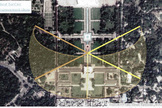 [image error]
[image error]
 From a viewpoint in the lower central portion of the gardens, where two pathways intersect the waterway, another series of alignments is visible. During the summer solstice, the sun would rise in alignment with a pavilion to the northeast and set in alignment with a pavilion to the northwest. During the winter solstice, the sun would rise in alignment with a pavilion to the southeast and set in alignment with a pavilion to the southwest.
From a viewpoint in the lower central portion of the gardens, where two pathways intersect the waterway, another series of alignments is visible. During the summer solstice, the sun would rise in alignment with a pavilion to the northeast and set in alignment with a pavilion to the northwest. During the winter solstice, the sun would rise in alignment with a pavilion to the southeast and set in alignment with a pavilion to the southwest.Credit: Image copyright Digital Globe, courtesy Amelia Carolina SparavignaView full size imageAlthough the alignments at the Taj Mahal likely had symbolic meanings, it's also possible that the architects of the structure used the solstice sun to help build the Taj Mahal, which is precisely oriented along a north-south axis. [In Photos: A Walk Through Stonehenge]
"In fact, architects have six main directions: two are joining cardinal points (north-south, east-west) and four are those given by sunrise and sunset on summer and winter solstices,"Sparavignawrote in her paper.
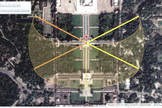 [image error]
[image error]
 From the vantage point of the Taj Mahal's central spring, there are alignments between the pathways during the solstice. In this image, the top yellow and orange lines represent sunrise and sunset on the summer solstice, while the bottom yellow and orange lines represent sunrise and sunset on the winter solstice.
From the vantage point of the Taj Mahal's central spring, there are alignments between the pathways during the solstice. In this image, the top yellow and orange lines represent sunrise and sunset on the summer solstice, while the bottom yellow and orange lines represent sunrise and sunset on the winter solstice. Credit: Image copyright Digital Globe, courtesy Amelia Carolina SparavignaView full size imageSparavigna told Live Science in an email
 that the alignments seen at the Taj Mahal, compared with solar alignments seen at other gardens, are particularly precise. In "the case of Taj Mahal, these gardens, which are huge, are perfect."
that the alignments seen at the Taj Mahal, compared with solar alignments seen at other gardens, are particularly precise. In "the case of Taj Mahal, these gardens, which are huge, are perfect."New technologies
Sparavigna made the discoveries by using an app called Sun Calc, which uses Google Earth satellite imagery to help calculate the direction at which the sun rises and sets on a given day and location.
Over the past decade the availability of free, high-resolution Google Earth imagery, combined with the development of apps like Sun Calc and Sollumis, has made it easier for researchers to discover and study solar alignments at historical sites.
"Before software
 and satellites, we had to use traditional maps or plans, obtained after local surveying, and equations to determine the solar [angles] and draw them on maps. In fact, the use of satellites [makes] this work very fast and visually attractive," Sparavigna told Live Science.
and satellites, we had to use traditional maps or plans, obtained after local surveying, and equations to determine the solar [angles] and draw them on maps. In fact, the use of satellites [makes] this work very fast and visually attractive," Sparavigna told Live Science.In December 2014, she published another paper reporting her discovery of solstice alignments at a Roman fort in northern England.
Published on February 04, 2015 06:14
Prehistoric Grave May Be Earliest Example of Death During Childbirth
by Megan Gannon
Live Science
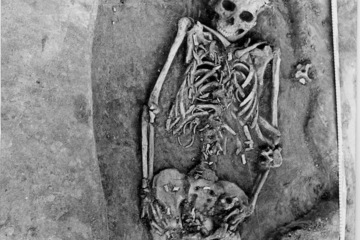
 Fetal bones are clearly visible around the abdomen, pelvis and thighs of this woman, buried between 7725 and 7630 years ago, according to carbon dating.
Fetal bones are clearly visible around the abdomen, pelvis and thighs of this woman, buried between 7725 and 7630 years ago, according to carbon dating.
Credit: Vladimir Bazaliiskii
Archaeologists say they've made a grim discovery in Siberia: the grave of a young mother and her twins, who all died during a difficult childbirth about 7,700 years ago.
The finding may be the oldest confirmed evidence of twins in history and one of the earliest examples of death during childbirth, the researchers say.
The grave was first excavated in 1997 at a prehistoric cemetery in Irkutsk, a Russian city near the southern tip of Lake Baikal, the oldest and deepest freshwater lake in the world. The cemetery has been dubbed Lokomotiv because it was exposed in the base of a hill that was being carved out during construction of the Trans-Siberian Railway in 1897. [8 Grisly Archaeological Discoveries]
Because the cemetery is partially covered by city development, it hasn't been fully excavated. All 101 of the bodies found so far at Lokomotiv were members of a hunter-gatherer community that roamed the area between 8,000 and 7,000 years ago. It's rare to find transient hunter-gatherer communities who buried their dead in formal cemeteries, but archaeologists have documented this practice at several other sites in northeastern Asia.
Angela Lieverse, an archaeologist at the University of Saskatchewan in Canada, studies these communities with the Baikal-Hokkaido Archaeology Project. In 2012, Lieverse was revisiting some of the bones found at Lokomotiv, which were in storage at Irkutsk State University. The occupants of the grave in question had initially been interpreted as a mother, 20 to 25 years old, and a single child. But when Lieverse pulled out the box of fetal remains, she said she quickly realized there were duplicates of four or five of the fragile bones.
"Within 5 minutes, I said to my colleague, 'Oh my gosh; these are twins,'" Lieverse told Live Science.
The fetal bones were all found within the mother's pelvic area and between her thighs. By analyzing the original placement of the remains, Lieverse reconstructed a traumatic childbirth scenario that even today — with modern medicine and the option of a C-section — would have been risky for the mother and her babies.
It seemed that one of the twins might have been breech (positioned with its feet down) and was partially delivered, Lieverse said. The second twin was positioned with its head down and seems to have remained in the womb. Lieverse thinks the breech baby may have been trapped or locked with its sibling, leading to a fatal obstructed birth.
"It might be a bit circumstantial, but I think it's quite strong," Lieverse said of her interpretation. She added that there has been very little postmortem shifting of the bones found at Lokomotiv, and everything is in place on the mother, even her ribs and little bones in her hands.
What makes the discovery remarkable is that cases of death during childbirth and instances of twins tend to be invisible in the archaeological record. There have been some cases of babies of a similar age buried in the same grave, but even if you had "impeccably preserved DNA," it would still be difficult to tell if these were twins and not siblings or cousins, Lieverse said.
Maternal death would have been common in prehistory. Still, it's hard to find archaeological evidence of a woman dying during childbirth — even if she died with a baby still inside of her. For instance, in ancient Rome, the law known as Lex Caesaria mandated that if a pregnant woman died, her baby had to be cut out her womb before she could be buried. Even if a woman's baby was left in the womb after she died, gas from the decomposing body might force the fetus out in what's known as a coffin birth. Fetal bones are also quite fragile and are less likely to survive than adult bones.
It's hard for archaeologists to know, based on this one burial, what this hunter-gatherer community thought of twins or death during childbirth. The young mother was buried lying on her back with several marmot teeth adorning her corpse — quite typical of the graves at Lokomotiv, Lieverse said.
"It suggests either they didn't know she had twins or that dying during childbirth wasn't so out of the realm of possibility that it would be considered unique," Lieverse said.
The finding was reported in the February issue of the journal Antiquity.
Live Science

 Fetal bones are clearly visible around the abdomen, pelvis and thighs of this woman, buried between 7725 and 7630 years ago, according to carbon dating.
Fetal bones are clearly visible around the abdomen, pelvis and thighs of this woman, buried between 7725 and 7630 years ago, according to carbon dating. Credit: Vladimir Bazaliiskii
Archaeologists say they've made a grim discovery in Siberia: the grave of a young mother and her twins, who all died during a difficult childbirth about 7,700 years ago.
The finding may be the oldest confirmed evidence of twins in history and one of the earliest examples of death during childbirth, the researchers say.
The grave was first excavated in 1997 at a prehistoric cemetery in Irkutsk, a Russian city near the southern tip of Lake Baikal, the oldest and deepest freshwater lake in the world. The cemetery has been dubbed Lokomotiv because it was exposed in the base of a hill that was being carved out during construction of the Trans-Siberian Railway in 1897. [8 Grisly Archaeological Discoveries]
Because the cemetery is partially covered by city development, it hasn't been fully excavated. All 101 of the bodies found so far at Lokomotiv were members of a hunter-gatherer community that roamed the area between 8,000 and 7,000 years ago. It's rare to find transient hunter-gatherer communities who buried their dead in formal cemeteries, but archaeologists have documented this practice at several other sites in northeastern Asia.
Angela Lieverse, an archaeologist at the University of Saskatchewan in Canada, studies these communities with the Baikal-Hokkaido Archaeology Project. In 2012, Lieverse was revisiting some of the bones found at Lokomotiv, which were in storage at Irkutsk State University. The occupants of the grave in question had initially been interpreted as a mother, 20 to 25 years old, and a single child. But when Lieverse pulled out the box of fetal remains, she said she quickly realized there were duplicates of four or five of the fragile bones.
"Within 5 minutes, I said to my colleague, 'Oh my gosh; these are twins,'" Lieverse told Live Science.
The fetal bones were all found within the mother's pelvic area and between her thighs. By analyzing the original placement of the remains, Lieverse reconstructed a traumatic childbirth scenario that even today — with modern medicine and the option of a C-section — would have been risky for the mother and her babies.
It seemed that one of the twins might have been breech (positioned with its feet down) and was partially delivered, Lieverse said. The second twin was positioned with its head down and seems to have remained in the womb. Lieverse thinks the breech baby may have been trapped or locked with its sibling, leading to a fatal obstructed birth.
"It might be a bit circumstantial, but I think it's quite strong," Lieverse said of her interpretation. She added that there has been very little postmortem shifting of the bones found at Lokomotiv, and everything is in place on the mother, even her ribs and little bones in her hands.
What makes the discovery remarkable is that cases of death during childbirth and instances of twins tend to be invisible in the archaeological record. There have been some cases of babies of a similar age buried in the same grave, but even if you had "impeccably preserved DNA," it would still be difficult to tell if these were twins and not siblings or cousins, Lieverse said.
Maternal death would have been common in prehistory. Still, it's hard to find archaeological evidence of a woman dying during childbirth — even if she died with a baby still inside of her. For instance, in ancient Rome, the law known as Lex Caesaria mandated that if a pregnant woman died, her baby had to be cut out her womb before she could be buried. Even if a woman's baby was left in the womb after she died, gas from the decomposing body might force the fetus out in what's known as a coffin birth. Fetal bones are also quite fragile and are less likely to survive than adult bones.
It's hard for archaeologists to know, based on this one burial, what this hunter-gatherer community thought of twins or death during childbirth. The young mother was buried lying on her back with several marmot teeth adorning her corpse — quite typical of the graves at Lokomotiv, Lieverse said.
"It suggests either they didn't know she had twins or that dying during childbirth wasn't so out of the realm of possibility that it would be considered unique," Lieverse said.
The finding was reported in the February issue of the journal Antiquity.
Published on February 04, 2015 06:04



